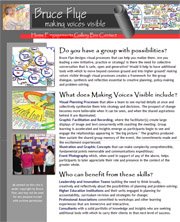Thanks to Richard Karash I’ve been reading O’Connor and McDermott’s The Art of Systems Thinking. I have to admit that as a novice on the topic I found the first few attempts challenging, but that was before mainlining on systems thinking at the Pegasus Conference. I sat down with it again yesterday and it now reads like a novel!
In their explanation of generative learning, they describe the changes that can take place in our mental models. The change occurs in response to feedback that can only be received through our senses. This might be from messages in our body such as pain, discomfort or general un-ease. It can also be messages from other people’s bodies by way of tones in speech or body language. Unfortunately we each have thresholds in that sensitivity, often a product of our mental models themselves, that cause us to miss the feedback.
In what ways might we improve that sensitivity? I’m thinking a place to start is with a change in the medium. In a post below is a description  of using Visual Explorer as a tool for finding a message inside us. We can also learn from our own images as described in Fox and Ganim’s Visual Journaling: Going Deeper than Words. Their process begins with noticing the messages from our bodies, and visualizing what those sensations might look like. I have found that as I work into the depths of their program, images and messages have appeared that were astounding. They seemed to have been imported from somewhere or someone as they just didn’t “fit” my usual lexicon. Among my mental models is one that says when I surprise myself, it’s time to pay attention and learn something.
of using Visual Explorer as a tool for finding a message inside us. We can also learn from our own images as described in Fox and Ganim’s Visual Journaling: Going Deeper than Words. Their process begins with noticing the messages from our bodies, and visualizing what those sensations might look like. I have found that as I work into the depths of their program, images and messages have appeared that were astounding. They seemed to have been imported from somewhere or someone as they just didn’t “fit” my usual lexicon. Among my mental models is one that says when I surprise myself, it’s time to pay attention and learn something.
Such visual work can go even deeper if we use Tsultrim Allione’s Feeding Your Demons. As in Visual Journaling one begins by noticing an internal sensation, and then visualizing it. The next step is to then personalize the image by looking for its living features like eyes, ears, hands a mouth; at that point one of your Demons has appeared. A conversation follows that leads you to offering the Demon what it tells you it needs, and then seeing it transform. Under certain circumstances, an Ally can emerge at the end of this e xchange.
xchange.
Among the reasons I was drawn to the book was a conversation I had with Diana Whitney. I had tossed out that old line about how people resist change, and she issued a pointed rejoinder: “People don’t resist change. They resist any situation in which they’re not getting something they need.” Might we work with our Mental Models as with our Demons: by giving them what they need and allowing the transformation to unfold?


No comments:
Post a Comment